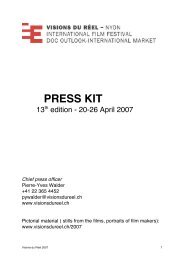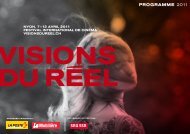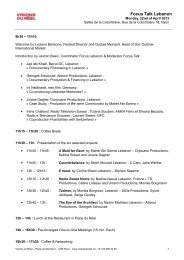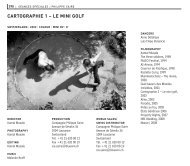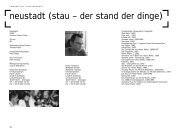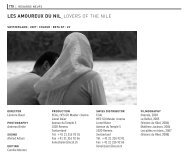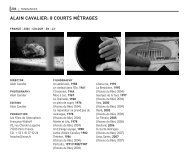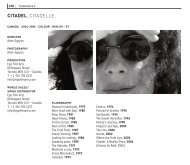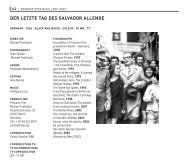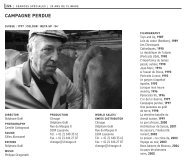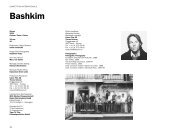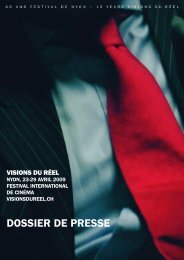Katalog 2013.pdf - Visions du Réel
Katalog 2013.pdf - Visions du Réel
Katalog 2013.pdf - Visions du Réel
You also want an ePaper? Increase the reach of your titles
YUMPU automatically turns print PDFs into web optimized ePapers that Google loves.
114 helvétiques<br />
Rachel Noël<br />
Ma mère<br />
s’appelle Forêt<br />
Switzerland | 2013 | 59’ | DV, Super 8 | Dutch, French<br />
My Mother’s Name is Forest<br />
World Premiere<br />
Cinematography<br />
Michel Noël, Rachel Noël<br />
Sound<br />
Matthieu Fichet<br />
Editing<br />
Jeanne Oberson<br />
Pro<strong>du</strong>ction<br />
Fabrice Aragno<br />
(Casa Azul Films)<br />
Filmography<br />
2013 Ma mère s’appelle<br />
Forêt (mlf)<br />
Contact<br />
Rachel Noël<br />
+41 797778266<br />
rachel@mameresappelleforet.ch<br />
www.mameresappelleforet.ch<br />
« A la mort de mon père, ma mère a réuni<br />
tous les films qu’il a tournés et me les a<br />
donnés. Il y a six heures de films. Seize<br />
ans de la vie de mes parents. Je n’ai<br />
aucun souvenir de ces images» (RN).<br />
En spectatrice privilégiée, la cinéaste<br />
fait défiler ces films super 8 et s’étonne,<br />
découvre, s’interroge. Ce sont d’abord<br />
des regards – qui évoluent au fil des<br />
ans : celui de l’homme sur sa fiancée,<br />
future épouse, puis mère, et sur les<br />
enfants qui naissent et grandissent ;<br />
ceux de la femme à son mari qui la<br />
filme ; celui que la fille devenue a<strong>du</strong>lte<br />
porte sur la figure de sa mère, comme<br />
sur ces bobines reçues en héritage. Ce<br />
sont aussi des images : celle que l’on<br />
a de soi, de ses parents, les souvenirs<br />
que l’on garde, confrontés à ces reliques<br />
que sont films et photos. Recomposant<br />
le puzzle de son histoire familiale, la<br />
cinéaste fait œuvre de montage, et<br />
agence avec finesse textes, sons et<br />
images, en variant le rythme et les<br />
temps. Au final, dans ce jeu de miroirs<br />
entre passé et présent, des identités et<br />
des rôles se construisent : une mère, une<br />
fille, ou comment devenir femme, d’une<br />
génération à l’autre.<br />
«Nach dem Tod meines Vaters gab mir<br />
meine Mutter alle Filme, die mein Vater<br />
gedreht hatte. Insgesamt sechs Stunden<br />
Film. Sechzehn Jahre des Lebens<br />
meiner Eltern. Ich habe keine Erinnerung<br />
an diese Bilder» (RN).<br />
Die Filmemacherin lässt als privilegierte<br />
Betrachterin diese Super 8 Filme<br />
vorbeiziehen und staunt, entdeckt und<br />
stellt Fragen. Zunächst sind es Blicke<br />
– und sie ändern sich mit den Jahren:<br />
die des Mannes auf seine Verlobte, bald<br />
Ehefrau und Mutter, und auf die Kinder,<br />
die auf die Welt kommen und aufwachsen;<br />
die der Frau auf den sie filmenden<br />
Ehemann; die der erwachsenen Tochter<br />
auf das Gesicht ihrer Mutter und auf<br />
die geerbten Filmspulen. Es sind auch<br />
Bilder: Bilder, die man sich von sich<br />
selbst, von seinen Eltern macht, Erinnerungen,<br />
die mit den Film und Foto gewordenen<br />
Reliquien konfrontiert werden. Für<br />
die Wiederherstellung des Puzzles ihrer<br />
Familiengeschichte greift die Filmemacherin<br />
auf den Schnitt zurück und fügt<br />
scharfsinnig in wechselnden Rhythmen<br />
und Zeiten Bild und Ton zusammen. Ein<br />
Spiel mit der Spiegelung von Vergangenheit<br />
und Gegenwart, das Identitäten<br />
und Rollen herausbildet: eine Mutter,<br />
eine Tochter, oder wie man von einer zur<br />
nächsten Generation Frau wird.<br />
“On the death of my father, my mother<br />
gathered together all the films that he<br />
had shot and gave them to me. There<br />
are six hours of film. Sixteen years of my<br />
parents’ life. I have no memory of these<br />
images” (RN).<br />
The filmmaker becomes a privileged<br />
spectator; watching these Super 8 films<br />
one by one, she is astonished, makes<br />
discoveries and asks questions. Above<br />
all, these are looks, which evolve over the<br />
years: a man looking at his fiancée, wife<br />
to be, then mother, and at his children<br />
who are born and grow up; the woman<br />
looking at the husband who is filming<br />
her; the girl, now an a<strong>du</strong>lt, looking at her<br />
mother and on these reels received in<br />
inheritance. They are also images: the<br />
image one has of oneself, of one’s parents,<br />
the memories that one keeps, facing<br />
these filmed and photographic relics.<br />
As she reconstructs the jigsaw of her<br />
family history, the filmmaker makes use<br />
of montage and delicately builds text,<br />
sound and image by varying the rhythm<br />
and tempo. Ultimately, in this hall of mirrors<br />
connecting the past and present,<br />
identities and roles are constructed:<br />
mother, daughter, or how to become a<br />
woman, from one generation to the next.<br />
Alessia Bottani



